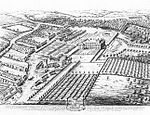Londesborough railway station
1847 establishments in EnglandBeeching closures in EnglandDisused railway stations in the East Riding of YorkshireFormer York and North Midland Railway stationsGeorge Townsend Andrews railway stations ... and 5 more
Pages with no open date in Infobox stationRailway stations in Great Britain closed in 1965Railway stations in Great Britain opened in 1847Use British English from March 2017Yorkshire and the Humber railway station stubs

Londesborough railway station was a station on the York to Beverley Line in the East Riding of Yorkshire, England. It opened on 4 October 1847 and served the villages of Shiptonthorpe and Londesborough. The station was originally named Shipton & Londesborough, was renamed to Shipton in April 1864 and became Londesborough in January 1867. It closed after the last train ran on 27 November 1965.
Excerpt from the Wikipedia article Londesborough railway station (License: CC BY-SA 3.0, Authors, Images).Londesborough railway station
Shiptonthorpe Road,
Geographical coordinates (GPS) Address External links Nearby Places Show on map
Geographical coordinates (GPS)
| Latitude | Longitude |
|---|---|
| N 53.8828 ° | E -0.7054 ° |
Address
Londesborough
Shiptonthorpe Road
YO43 3RY , Shipton Thorpe
England, United Kingdom
Open on Google Maps









